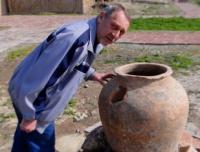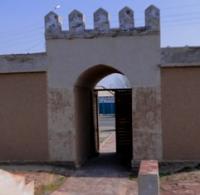Вы здесь
Tortkol caravanserai in Taraz.


Holidays tour in Taraz.
"Foot of an infant touching
Debris of piles of secular;
And the sun was slow, saying goodbye
With a hill and a castle and you”
Fedor Ivanovich Tyutchev. "I remember the golden time."
Ancient fortifications of Zhambyl region.
On the territory of Kazakhstan, one of the preserved historical sites is the medieval caravanserai “Tortkul” (Tortkol) (translated from Kazakh as “quadrangle”), located on Suleymanova Street in the western part of modern Taraz. Once he probably had a name, but it is forgotten.
This caravanserai functioned during the XI - XIII centuries. and was destroyed, apparently, during the civil strife in the post-Mongol time. In 1983 - 1985, the Taraz Archaeological Expedition of the Institute of Archeology and Ethnography of the Academy of Sciences of Kazakhstan under the leadership of K.M. Baipakova conducted the first scientific research of Tortkol.
Excavation work was concentrated on a small area, on a hill near the northwestern edge of the facility. Researchers have fixed the upper layer, under which the remains of medieval structures were discovered. In 2008, at the initiative of the Department of Culture of the Office of Zhambyl Oblast, the study of this unique monument was resumed.
In the course of research, it was found that the caravanserai was a quadrangular structure surrounded by walls whose width reached four meters. The walls were fortified with rounded corner towers and half towers.
The main entrance to the territory of the caravanserai, designed as a portal-pestak, was arranged in the southwest wall. He led to the territory of the vast central courtyard. Inside the walls in the southwestern section of the caravanserai, ten rooms are open.
An isolated room with a sufa for an overnight stay of 6 - 9 square meters. m had a small heating tandoor with through cutting. On the economic site near the tandoor were household items: a plate, a bowl, a lamp and a jug of water. Each room had an exit to the corridor, and its doors led residents to the courtyard.
There are rooms with a separate exit. In one of the rooms a clay table on three legs with a coin lying on it was found. Eleven rooms were opened in the southwestern section. The rooms in the northwestern part have an area of 12 - 14 square meters. m. In each of them there are a souffle for relaxation, a tandoor or a small hearth, lined with mud brick.
The north-eastern side includes residential and storage facilities. A narrow, long room with one entrance in the south wall could serve as a warehouse. The other two square-shaped rooms have a wall-mounted sufa and a fireplace. In the middle of another room lies a large stone slab for the pillar.
The room with the entrance to the eastern wall attracts attention. Its area is 25 square meters. m. Along the fortress wall there is a wide suffa with a heating system. On the opposite side is also a sufa, in which an oval-shaped fireplace is built in. In the southwestern corner, a raw brick laid a circle of one brick in height, and inside there are stones.
In the eastern wall of the same corridor there were doors to storage rooms, where grain was stored in utility pits. There are three enfilade rooms, completely isolated from the others, where there are concentrated household, production centers and two medium-sized tandoor.
These premises could be a workshop. The main material discovered during excavations is ceramics, which are divided into a dining room, utensils for cooking and large vessels for storing food. In the manufacture of pots for cooking, standardization is observed (one size, one pattern).
There are dishes and bowls covered with glaze and murals. These expensive items were brought from Iran. Two fragments from bowls were also found, on which inscriptions were written in Kufi's handwriting. Judging by the manufacturing technique, they could have been brought from Samarkand.
Currently, a complete reconstruction of the caravanserai is planned. And the archaeological and conservation-restoration measures carried out helped to lay the foundation for the creation of the museum complex “Medieval Caravanserai of Ancient Taraz”.
Thus, Taraz, a large center on the Great Silk Road, which was called the “city of merchants” in the Middle Ages, will have a wonderful tourism object - a restored caravanserai.
Authority:
Magazine "World of Travel", 2012. Karl Baipakov, Dmitry Voyakin.
Photos
Alexander Petrov.







